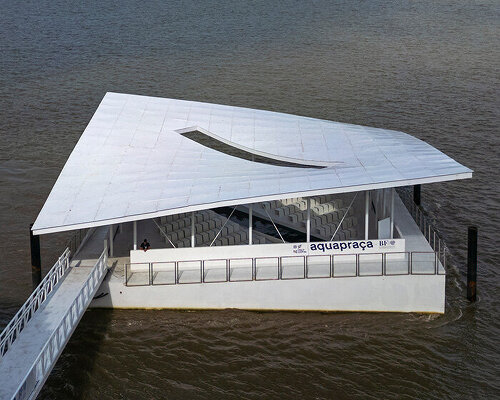carlo ratti and Höweler + Yoon’s AquaPraça arrives in brazil
AquaPraça, the 400 square-meter floating plaza by CRA – Carlo Ratti Associati and Höweler + Yoon is officialy anchored along Guajará Bay for COP30, becoming one of the summit’s most visible architectural statements on climate adaptation. Unveiled in Belém by Italy’s Ministry of Foreign Affairs and International Cooperation, the Ministry of Environment and Energy Security, and the COP30 Presidency, the platform is conceived as a civic space where visitors can literally meet rising water at eye level (find designboom’s previous coverage here). After the conference ends, AquaPraça will remain permanently in the Amazon River system, donated by Italy to the State of Pará as a cultural infrastructure for public programming around climate, creativity, and community engagement.
First presented in a simplified prototype during the Biennale Architettura 2025 in Venice, AquaPraça arrives in Brazil in its complete form, now equipped with a lightweight roof structure and reconfigured circulation for the tidal conditions of Belém. The Amazon Delta experiences shifts of up to four meters per day, periodically exposing the sandy, sedimented underbelly of the bay, a phenomenon the architects intentionally foreground. The plaza floats according to Archimedes’ principle, rising and falling with the estuarine currents where freshwater and saltwater merge. Sloping planes tilt gently toward the water, railings frame views of the shifting shoreline, and the edge condition becomes an active interface rather than a boundary.
all images by Leonardo Finott, unless stated otherwise
a platform for cooperation and a legacy project at cop30
At COP30, AquaPraça extends the historic House of Eleven Windows, creating an informal waterfront forum for symposia, public talks, screenings, and cultural programs related to the Italian Pavilion. The structure’s steel body, engineered and fabricated in just five months by Cimolai, is finished with crisp geometric lines that contrast the soft horizon of Guajará Bay. From afar, the platform reads as a bright, low-lying rectangle hovering on the water, while up close, it opens into a porous interior with shaded zones, stepped surfaces, and outward-facing views toward the river, mangroves, and passing boats. In the high humidity and diffuse Amazonian light, the metal surfaces take on a cool matte sheen, reflecting sky tones without becoming mirror-bright. ‘Ecology and freedom are not in contradiction, but must be part of a common destination towards the future of humanity,’ notes Minister Antonio Tajani during the opening in Belém, adding that the ‘floating Italian square’ will stay in the Amazon as a symbol of friendship and cooperation between the two countries.
For the team at CRA, the project folds into a longer curatorial narrative that began in Venice. Carlo Ratti describes the installation as a multi-chapter experiment in circularity and mobility. ‘The project was always conceived as a journey: a structure with many lives. From Venice to Belém as Italy’s pavilion for COP30, and will ultimately remain in the Amazon as permanent cultural infrastructure. This is the essence of circularity — the continual reuse and reinvention over time,’ he shares. Höweler + Yoon approaches the platform as an embodied metaphor for balance. ‘AquaPraça lets visitors meet the sea at eye level,’ says Eric Höweler. ‘Its sloping surfaces and shifting levels embody a delicate equilibrium.’ J. Meejin Yoon expands on the idea of shared responsibility. ‘It’s a platform, both literal and figurative, for deepening our collective understanding and experience of sea level rise and the impacts of climate change on global cities and communities — and seeking collective solutions,’ he comments.
AquaPraça by CRA – Carlo Ratti Associati and Höweler + Yoon is officialy anchored along Guajará Bay
completed in record-time and engineered for the tides of belém
Behind the floating silhouette lies a compressed production timeline. Cimolai, Italy’s advanced steel construction company, completed structural design, assembly, and certification in just five months, coordinating with engineering and technical teams across time zones. ‘The real challenge was to complete the platform in record time,’ reflects Cimolai president Marco Sciarra.
The final structure measures roughly 400 square meters, supported by a buoyant steel chassis and stabilized for the Amazon Delta’s tidal oscillations. The roof lightly hovers over the deck, creating shade while keeping the horizon unobstructed. Circulation pathways widen at corners to become gathering pockets, while the perimeter frames water-level views that shift throughout the day. At low tide, the plaza appears to lift above exposed sediment; at high tide, it sits just centimeters above the surface, making the city’s hydrological rhythms physically palpable.
AquaPraça’s evolution between Venice and Belém is visible in its material refinement and expanded public role. In Venice, the project read as a minimal steel diagram, a teaser for what was to come. In Belém, it takes on full programmatic density as an open-air institution, operating at the scale of both urban infrastructure and diplomatic stage.
the 400 square-meter floating plaza is an architectural statement on climate adaptation
conceived as a civic space where visitors can literally meet rising water at eye level
AquaPraça will remain permanently in the Amazon River system
a cultural infrastructure for public programming around climate, creativity, and community engagement
image by Peter White
image by Peter White
project info:
name: AquaPraça
architect: CRA–Carlo Ratti Associati | @crassociati, Höweler + Yoon | @howeleryoonarchitecture
collaborators: Italy’s Ministry of Foreign Affairs and International Cooperation, Italy’s Ministry of Environment and Energy Security, Brazil’s Ministry of Foreign Affairs, CIHEAM Bari, World Bank Group’s Connect4Climate program, Bloomberg Philanthropies
location: Guajará Bay, Belém, Brazil
area: 400 sqm (4,000 sq ft)
The post carlo ratti and höweler + yoon’s floating aquapraça drifts from venice to belém for COP30 appeared first on designboom | architecture & design magazine.

